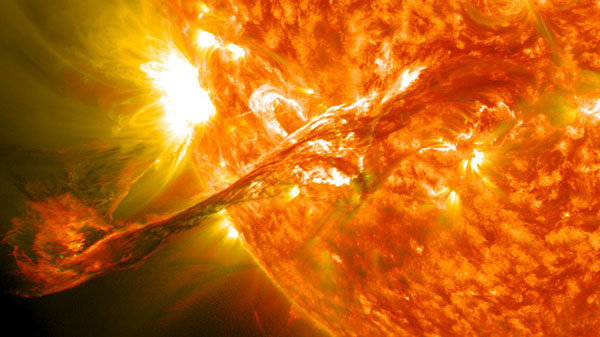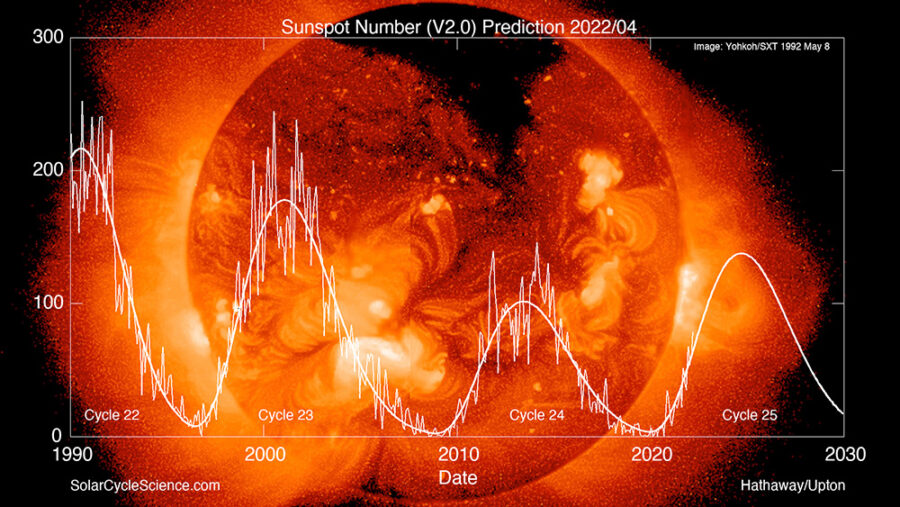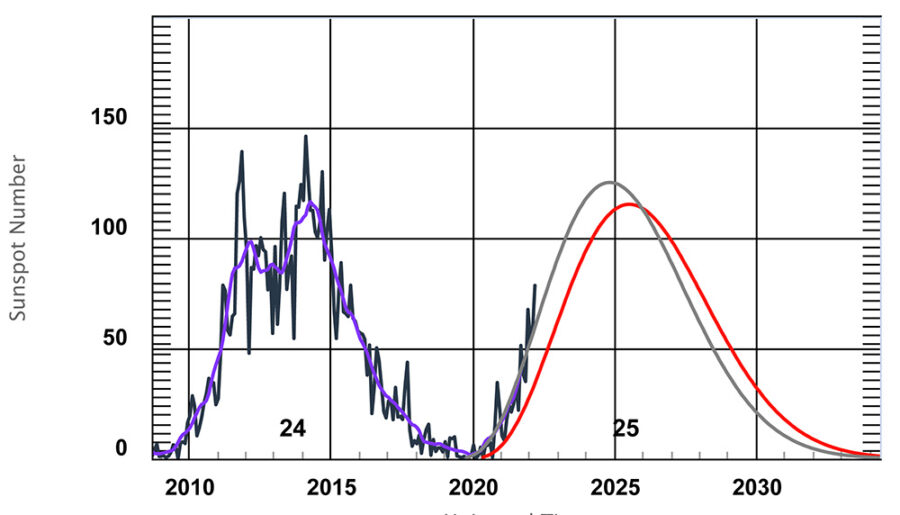The Sun is ramping up activity, but contrary to some reports, this solar cycle is still consistent with scientists’ predictions.

The Sun is waking up.
In recent weeks, NASA has announced X-class solar flares, observers have seen large sunspot groups with the unaided eye, and online services have issued multiple aurora alerts even for mid-latitudes.
After years of quiescence — the Sun was more often spotless than not in 2018, 2019, and 2020 — the change of pace is exciting solar observers. The Sun goes through 11-year cycles of magnetically instigated activity, which include sunspots, flares, and massive eruptions. While such activity last peaked around 2012 through 2014, that maximum was meager at best. In fact, it marked one of the quietest cycles in 100 years.
Now, the uptick in activity seems to mark a change in the Sun’s behavior. Lisa Upton (Space Systems Research Corporation), co-chair of the Solar Cycle 25 Prediction Panel, says that for the first time in 50 years, this solar cycle seems to be stronger than the one before it. She and colleague David Hathaway are predicting that this cycle will be up to 30% more active.

L. Upton & D. Hathaway / Yohkoh SXT
“This may mean that we have reached the inflection point in the current Gleissberg cycle and might start to see bigger cycles,” Upton speculates. “It's a bit too early to say for sure, though.”
However, contrary to some online reports, she emphasizes that we shouldn’t expect too much from the Sun’s current activity. “The cycle is following very nicely along the strongest/earliest of [the panel’s] predictions and is certainly on track to be another weak cycle,” she adds.
“We still consider this cycle to be below average,” confirms panel co-chair Doug Biesecker (National Oceanic and Atmospheric Administration). “Even with the recent activity, the sunspot number is still within the error bars of the solar cycle prediction from the panel.”
Prediction vs. Reality
In 2019, that panel of experts reviewed the available models and predictions for the next solar cycle. In doing so, they recognized that physics-based scenarios were more successful than other prediction methods, such as those based on empirical data of the Sun’s behavior. In particular, the most successful models incorporated the behavior of the Sun’s magnetic fields, especially those at the poles, as well as an understanding energy flow within the turbulent solar interior.
As a result of these investigations, the panel came to a consensus: That the new solar cycle had started sometime between July 2019 and July 2020, and that activity would peak in 2025 with a maximum sunspot number between 105 and 125. The wiggle room in the prediction reflects that even the physics-based models are not in 100% agreement with one another.

Space Weather Prediction Center
Now, with two years of the cycle under our collective belt, the predictions are holding up well, albeit with numbers veering toward the earlier and higher end of the forecast. Understanding this slight shift will likely take a year or two more data, but Upton and Hathaway have a report coming out soon with preliminary findings (though you can read a summary of their findings here).
“I would say that the panel's forecast for solar cycle 25 is holding up very well,” Upton adds. “I believe this will likely be the best forecast to come out of one of the NOAA/NASA Cycle prediction panels.”
While scientists have a growing confidence in their ability to predict what the Sun will do next, that doesn’t mean there isn’t room for disagreement. Scott McIntosh (National Center for Atmospheric Research), for one, has gone against the consensus in predicting that this cycle will be one of the strongest on record.
Nearing the end of April 2022 #SunspotCycle25 is doing its thing. How long until 120 [monthly SSN]? pic.twitter.com/ZkJbCkxdnK
— Scott McIntosh (@swmcintosh) April 28, 2022
By 2023 if not before, it should become clear which prediction is correct.
The Solar Cycle and the 2024 Eclipse
The cycle’s earlier and more active start has practical consequences for communication satellites and power grids, both of which can suffer damage in severe space weather. But a more benign effect could await amateur astronomers.
The early start suggests an earlier maximum is likely, too, putting peak activity closer to the total solar eclipse set to sweep over Central and North America on April 8, 2024. As the Moon blocks the Sun's disk that day, it will reveal the wispy, white solar atmosphere that streams into space — and this corona could take on a drastically different shape depending on solar activity.
“We should have a very interesting Sun to see during the 2024 Great American Eclipse,” Upton says, “certainly very different from the 2017 Great American Eclipse.”
 0
0









Comments
You must be logged in to post a comment.